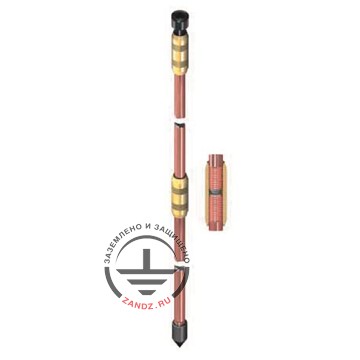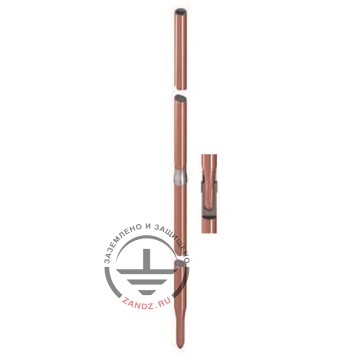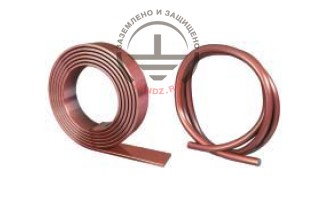To execute artificial ground electrodes, laid directly in the ground, the following is used: wire, stranded conductors, tape, rods, plates or bar screens. The requirements they must meet are contained in the most recent standards on electrical systems (PN-HD 60364-5-54: 2011 Electrical low-voltage systems - Part 5 - 54: Selection and erection of electrical equipment - grounding schemes and protective conductors (orig ). [5], PN-EN 50522: 2011 Grounding of electrical power systems of alternating current with voltage up to 1 kV), as well as lightning protection systems (PN-EN 62305-3: 2011 Lightning Protection Part 3: Physical damage of facilities and life hazard (orig.), PN-EN 62561-2: 2012 Elements of lightning protection devices (LPSC) - Part 2: Requirements to conductors and ground electrodes (orig.) (previously as PN-EN 50164-2: 2010).
These documents contain requirements for the use of relatively acceptable materials, coating types and sizes of elements.
Requirements contained in standards PN-HD 60364-5-54:2011, PN-EN 62305-3:2011 and PN-EN 62561-2:2012, do not conflict with each other, but some requirements of standard PN- EN 50522:2011, which was approved by CENELEC as a European standard for the next period are different from the requirements of the other standards. Table 1 compares requirements referring to grounding elements gathered from the standards given above. The values that are different in separate documents are marked in red.
| Material | Form | Minimum sizes diameter / cross-section / thickness [thickness of the coating] mm / mm2/ Mm [m] |
||||
| PN-HD 60364-5-54: 20111) | PN-EN 50522: 2011 | PN-EN62305-3: 2011 | PN-EN 62561-2: 2012 | |||
| Copper | Uncoated / galvanized |
Wire | - / (25) 50 / - | - / 25 / - | - / 50 / - | 8/50 / - [1 micron] |
| tape | - / 50/2 | - / 50/2 | - / 50 / - | - / 50/2 [1 micron] | ||
| rod | (12) 15 / - / - | 15 / - / - | 15/176 / - [1 micron] | |||
| stranded wire2) | 1.7 / (25) 50 / - [1 micron] | 1.8 / 25 / - | - / 50 / - | 1.7 / 50 / - [1 micron] | ||
| pipe | 20 / - / 2 | 20 / - / 2 | 20 / - / - | 20/110/2 [1 micron] | ||
| plate3) | - / (1.5) 2 | 500x500 / - | 500x500 / 1.5 [1 micron] | |||
| bar screen | - / 2 | 600x6004)/ | 600x600 / - [1 micron]5) | |||
| galvanized | tape | - / 50/2 [20 microns] | ||||
| lead-coated | Wire | - / 20 / - [1000 microns] | ||||
| stranded wire | 1.8 / 25 / - [1000 microns] | |||||
| Steel | copper-plated by electroplating technique | Wire | (8) / - / - [70 microns] | - / 50 / - | 8 / 50 / - | |
| [250 microns] | ||||||
| 10/78 / - [70 microns] | ||||||
| tape | - / 90/ 3 [70 microns] | - / 90 / - | - / 90/ 3 [70 microns] | |||
| rod | 14 / - / - [250 microns] | 14.2 / - / - [90 microns] | 14 / - / - | 14 / 150 / - [250 microns] | ||
| copper coated | rod | 15) / - / - [2000 microns] | (15) / - / - [2000 microns] | |||
| lead-coated | Wire | 8 / - / [1000 microns] | ||||
| hot-dip galvanized | Wire | 10 / - / - [45 microns] | 10 / - / - [50 microns7)] | - / 78 / - | 10 / 78 / - | |
| tape | - / 90/3 [63 microns] | - / 90/3 [63 microns] | - / 90 / - | - / 90/ 3 | ||
| rod | 16 / - / - [45 microns] | 16 / - / - [63 microns] | 14 / - / - | 14 / 150 / - | ||
| stranded wire2) | - / 70 / - | |||||
| pipe | 25 / - / - 2 [45 microns] | 25 / - / - 2 [47 microns] | 25 / - / - | 25/140/2 | ||
| plate3) | 500x500 | 500x500 / 3 | ||||
| bar screen 3) | 600x6006) | 600x6004) / - 6) | ||||
| uncoated, in concrete | Wire | 10 / - / - | - / 78 / - | 10 / 78 / - | ||
| tape | - / 75/3 | - / 75 / - | - / 75/3 | |||
| stranded wire3) | - / 70 / - | 1.7 / 70 / - | ||||
| Stainless | wire | 10 / - / - | - / 78 / - | 10 / 78 / - | ||
| tape | - / 90 / 3 | - / 100 / - | - / 100 / - | |||
| rod | 16 / - / - | 15 / - / - | 15 / 176 / - | |||
| pipe | 25 / - / - 2 |
|
||||
Acceptable materials
In all the mentioned standards, it is recommended to use copper (uncoated or tinned) and steel (hot-dip galvanized, stainless or copper plated by electroplating technique) as the materials used for the manufacture of grounding elements. Standards for electrical systems (both PN-HD 60364-5-54:2011 and PN-EN 50522: 2011) allow to use steel with copper coating 1000 microns thick, but this material is subject to delamination of copper plating under the influence of mechanical factors. Taking this into consideration, lightning protection standards allow to only use steel, copper-plated by electroplating technique, which provides a far more durable contact of both layers, even if thickness of the copper plating is significantly thinner.
Standard PN-EN 50522 - the only one that allows the use of such materials as steel and copper, plated with lead. Considering harmful qualities of lead, such materials should not be used today.
Some differences between the recommendations of specific standards relate to steel, copper-plated by electroplating technique, which is gaining popularity in the recent years. PN-EN 50522 standard contains information about rods made of such material, but the remaining standards allow use of wire and tape. The minimum thickness of copper plating for vertical rods: 90 microns, given in PN-EN 50522, seems to be wrong. Lightning protection standards, like the standard for low-voltage systems, require that the thickness of this layer is at least 250 microns, because the coating thickness of 90 microns may be too fragile to mechanical impacts, which the rods are subject to when submerged in the ground. But the thinner coating thickness is admitted in case of wire and tape, which are horizontally laid in trenches and covered with ground, in the result of what they are less damaged.
It is not very logical, that low voltage system (the layer of which also should be 250 microns) are subject to stricter requirements than the systems with voltages greater than 1 kV. Today, not many manufacturers fulfill these requirements. For example, steel rods with copper coating 240 microns thick are available on the market. Though the difference is small, but it says that this product does not meet the regulatory requirements. Examples of special vertical coppered ground electrodes corresponding to the said standards, are shown in pic. 3.

a) threaded

b) clutchless
Pic. 3. Galmar vertical coppered ground electrodes with a copper coating thickness of 250 microns
For tapes, coppered by electroplating technique, requirements to thinner thickness of the coating derived from a smaller risk of damage to the coating of the ground electrode. Tapes, which are placed in trenches and covered with ground, are not exposed to significant mechanical stress, so copper coating 70 microns thick is enough for them (Pic.4). At that, a coppered tape should be sufficiently resistant to buckling, peeling of copper sheeting should not take place.

Pic. 4. Steel Galmar tape and wire with a copper coating 70 microns thick
The latest lightning protection standards do not specify too many requirements to the thickness of zinc coating, although such information was given in the previous version of the standard PN-EN 62305-3: 2009. It stated that zinc coating must be smooth, continuous and free of blemishes, and its minimum thickness should be 50 mm for round elements (wire and bars) and 70 m - for the flat elements (tape).
Element's minimum dimensions:
Standard PN-HD 60364-5-54, relating to low-voltage systems, indicate two sizes for individual elements (wire, stranded conductors and copper rods): for cases when the grounding system is designed only to protect against electric shock, and for cases, when it should also be used for lightning protection. Dimensions of grounding elements, such as the minimum diameter of the rods or cross- section of wire may be smaller when the ground electrode only performs operating functions or provides electrical safety and is not subject to lightning currents. Dimensions recommended in PN-EN 50522, coincide with the values specified in the PN-HD 60364-5-54 for this case. In this regard, it should be understood that the dimensions specified in PN-EN 50522, relate only to the application of the ground electrode to provide electrical safety. If the task of the ground electrode includes dispersion of the lightning current in the ground, it is necessary to stick to the more stringent requirements of standards PN-EN 62305-3: 2011 and PN-EN 62561-2: 2012.
The latest lightning protection standard PN-EN 62305-3: 2011 contains less detailed information about ground electrodes in comparison to the edition of 2009. As the first edition, the information concerning, among other things, the thickness of plates, thickness of copper and zinc coatings for steel rods, wire diameters is eliminated. Only the requirements for the diameters of rods, surface of cross-section of wires and tapes, as well as surface of plates and bar screens are left. Various detailed recommendations were transferred to PN-EN 62561-2 standard: 2012, except for the requirements to thickness of zinc layers. None of lightning protection standard contain such requirements now. It is also worth remembering that rods, copper-plated by electroplating technique, were already mentioned in standard PN-EN 50164-2: 2003, dedicated to conductors and ground electrodes, but only in 2011 they appeared in lightning protection standards, of series 62305.
Differences can be seen in minimum diameters of rods made of galvanized steel and stainless steel, as well as in sizes of stainless steel tapes. Standards for electrical systems recommend the use of rods with a diameter of 16 mm made of galvanized steel by a hot method, and stainless steel, wherein lightning protection standards allow smaller diameters - 14 and 15 mm, respectively. However, in practice the difference is of little importance, since the majority of manufacturers offer steel rods with a diameter of at least 16 mm (typical diameters - 16, 18 or 20 mm), which meet the requirements of both standards for lightning protection and electrical systems.
Read before
"Grounding of construction objects"
Related Articles:



